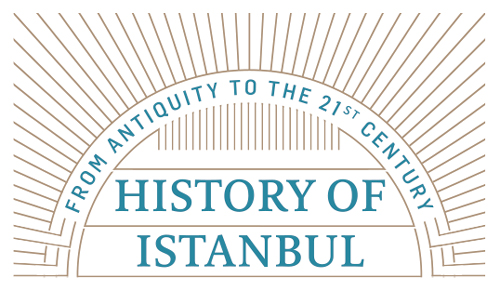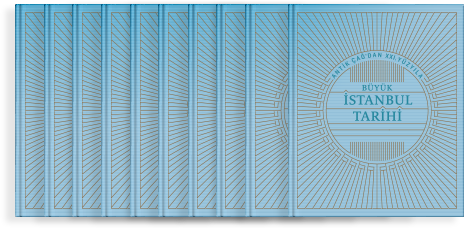Among the many bakeries in operation during Istanbul’s Ottoman era were those belonging to the palace, the army, imaret (charity) bakeries, embassy bakeries, and public bakeries.
Physically speaking, palace bakeries, or ovens, were a part of the Matbah-i Amire (Ottoman palace kitchen). The Matbah-i Amire was responsible for the proper functioning of ovens throughout the palace. On the other hand, the kilercibaşı (chief pantryman) of the Enderun (inner palace) was responsible for the appointment and dismissal of working personnel. Two kilercibaşıs worked in the palace: the Enderun kilercibaşı and the Birun (outer palace) kilercibaşı; the latter of which was the director of the Kilar-i Amire (palace pantry). The Enderun kilercibaşı was the superintendent of various personnel in the palace, such as the servants of the private and exterior ovens, bread makers and simit (Turkish bagel) makers, who worked in palace ovens and kitchens; he was also responsible for the appointment and dismissal of the same.1
The palace kitchen provided bread for various parts of the palace, including the Helvahane, (where halvah and other desserts were produced), the Harem-i Hümayun, (imperial harem), the Matbah-i Has (where the sultan’s food was produced), the Rikab-i Humayun (attendants of the sultan), and for the sultan, his family, and government officials. Bread was not distributed to these areas and people directly from the oven; it first had to enter the kitchen. An assortment of bread was produced in palace ovens, including both has and harci bread.2
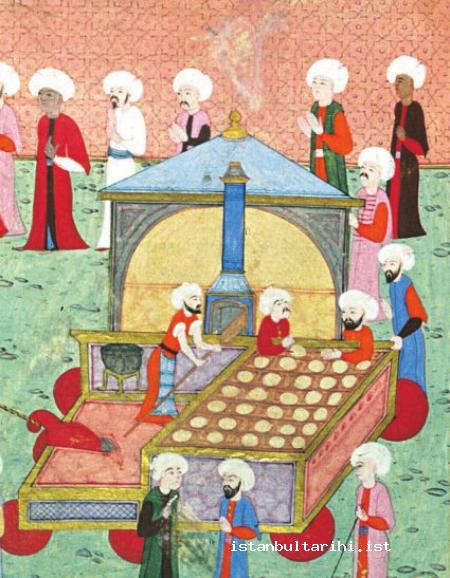
In Istanbul there were bakeries that produced fodla (a large, flat, soft Ottoman bread) only for the military corps. The first fodla oven -also known as a sekban (military) oven- was established during the reign of Sultan Mehmed II to provide food for hunting dogs. Although these ovens originally were established to make fodla for the dogs fed by the sekban,3 the zağarcı (a section of the Ottoman army), and the haseki (wives of Ottoman sultans), they later became transformed into bakeries that produced bread for the military corps. The hierarchical structure in the fodla bakery was similar to that of the palace bakery. There were bakers, dough makers, sievers and apprentices; together, these workers were known as the ekmekçi bölüğü (bakers’ company).4

During the Ottoman era, many charitable foundations were established all over the country to provide food and accommodation for those in need. Upon the conquest of Constantinople, many new foundations were established in both the city and other parts of the country. One of the most important charitable institutions was the imaret, and bakeries producing fodla bread were established in order to provide the imaret with food.5
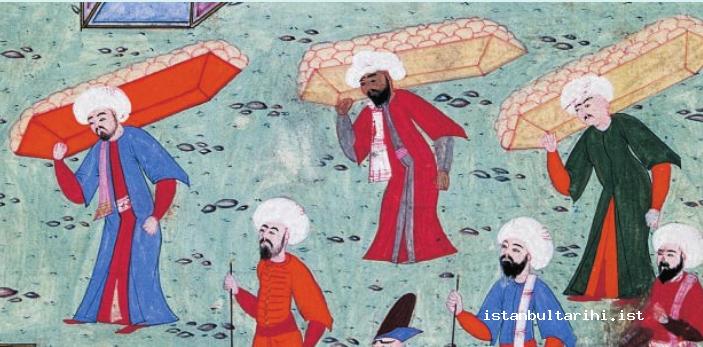
Occasionally, people were given bread from imaret ovens. When there was a scarcity of bread in the market, imaret ovens took the necessary precautions to meet the increased demands for bread from the public. Bread was produced daily in imaret ovens, and all of the bread produced in these bakeries was made from pure wheat; barley was rarely used in bread production, and instead being given to horses.
In the Ottoman capital, embassy bakeries were established to meet the demands of foreign embassies. These were mostly located around Galata, and often they produced baguettes of great quality. Foreign bakers produced baguettes for the consumption of rich customers. Because the baguette bakeries worked for foreign ambassadors for the most part, the government did not apply fixed prices to their products.6
Private bakeries (for public consumption) in Istanbul fell into two groups in terms of the type of bread they produced. These can be divided into has (pure) bread bakeries and harci bakeries. In terms of quality, has bread was better than harci bread. The reason for this was that white flour was used to produce this type of bread. The quantity of has bakeries was less than that of harci bakeries. The reason for this was the high price of has bread, and the consequent low demand. Though the prices of these two breads were equal, has bread was often lighter in weight. Has bakeries would occasionally make bread that weighed 30-40 dirhams (a dirham was equal to 3.2 grams) less than the regulation, thus breaking the law.7 At times, the government would decide on a fixed price without discriminating between has and harci bread.8 This practice was an attempt to eliminate confusion resulting from weight discrepancies.

Bread made in harci bakeries was typically of lower quality. Since its base weight tended to be higher, people with low incomes often consumed it; hence, it was in greater demand. For this reason there were bakeries all throughout Istanbul that produced harci bread. Apart from bread ovens, there were bakeries in Istanbul that produced other baked goods such as simit and börek.9
Bakeries did not typically produce baked goods outside their product range. It was forbidden, for example, for a börek-producing bakery to produce bread, just as it was for a bread-producing bakery to produce börek. Regulations involving bakeries stipulated this condition in concise wording. The only way to evade this was to breach the regulations; bakeries would complain about such infringements to try to prevent such practices.
Bread production permits were only granted to ovens that produced bread. Occasionally, however, börek makers would break the rules and produce bread in order to increase their profits. In order to prevent such competition which was achieved by evading the law, certain bakeries appealed to the divan (state council). It was also common for bread makers to try and solve such disputes among themselves. Even though it was forbidden for baguette bakeries to produce regular bread, it was common for them to do so. Faced with breaches of these regulations, the Istanbul kadılık (qadi’s office) often intervened in order to put an end to such infringements.10
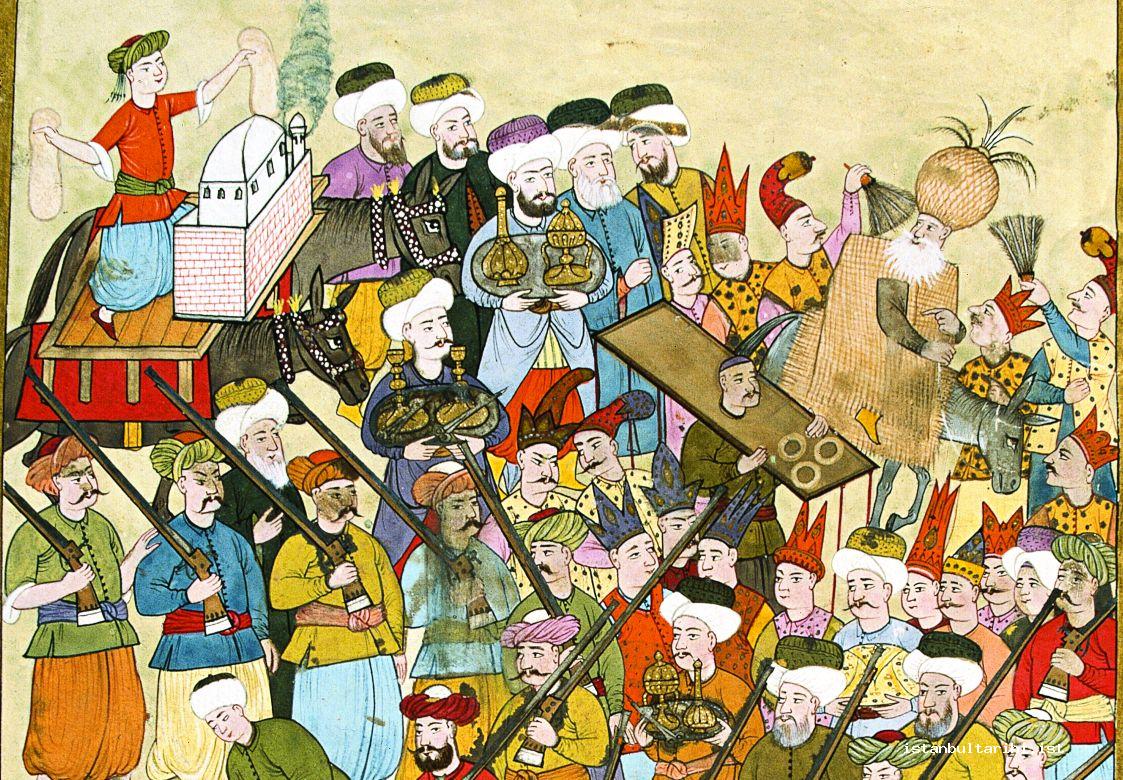
Bakeries typically sold their products in special areas assigned to them. In addition to selling bread and other bakery products directly from their bakeries, products could only be sold via the iskemleciler (bread sellers) who were affiliated with a certain oven; the number of these points was set out by law. An iskemle could be a shop (grocery store, kebab restaurant, etc.) or a stall. The iskemleci took bread and other products from the bakeries to which they were affiliated. It was forbidden for them to see anywhere but at their iskemle. Peddlers, who sold bread from trays, could only sell bread that came from the bakery for which they worked.11

In the Ottoman State price-fixing was applied to all staple foods, beginning with bread. In accordance with this, the government set an official price for bread and required that all commercial exchanges be carried out in accordance with this price. Except for products that fluctuated due to seasonal availability, the price of food did not often change. One of the products whose price did change depending on the season, however, was bread. Bread prices were fixed after initial harvests, and were changed later in the year, if necessary.12
Price-fixing for bread was also often subjected to weight regulations when economic changes occurred. Under normal circumstances, the price of bread was one akçe. In times of poverty or economic depression, though, the same product was sold for three-times its normal price. Of the products that were subjected to price-fixing, bread had the lower profit margin. Because it was a staple food, the government lowered the price, and thus the profit margin, of bread. This rate was generally 10%.13
Bakeries were generally required to follow strict regulations concerning the quality, weight and price of bread. Depending on certain regulations, certain products were given permission to be produced or were forbidden; these could only be produced at certain qualities. Muhtesib (officer responsible for public order) and koloğlans (patrols) frequently controlled these ovens in order to prevent any problems or setbacks. Consequently, ovens were obliged to maintain complete compliance with regulations concerning both quality and prices. There were explicit provisions relating to the quality of bread recorded in the ihtisab (public regulation) codes. According to these, it was especially important that the flour was well sifted and that the bread was sufficiently baked. It was also compulsory that dough for börek be half the amount of bread dough and the right amount of oil be added to the bread.14 In order to ensure that bakeries produced bread which complied with these regulations, the government distributed samples of correctly produced bread, and often required bakeries to bake bread that matched this standard. This was especially true during Ramadan, and orders were sent to officials telling them to ensure that government regulations were obeyed.15 In every era of the Ottoman capital, officials applied regulations on both the quality and the price of bread.16
FOOTNOTES
1 Arif Bilgin, Osmanlı Saray Mutfağı, Istanbul : Kitabevi, 2004, pp. 30, 64-65; İsmail Hakkı Uzunçarşılı, Osmanlı Devletinin Saray Teşkilatı, Ankara : Türk Tarih Kurumu, 1988, pp. 459-460; T. Talbot Rice, Bizans’ta Günlük Yaşam: Bizans’ın Mücevheri Konstantinopolis, tr. Bilgi Altınok, Istanbul: Özne Yayınları 2002 p. 26.
2 See: Mehmet Demirtaş, Osmanlıda Fırıncılık: XVII. Yüzyıl, Istanbul : Kitap Yayınevi, 2008, pp. 49-50.
3 Midhad Sertoğlu, Osmanlı Tarih Lugatı, Istanbul : Enderun Kitabevi, 1986, pp. 114-115.
4 BOA, AE, I. Ahmed, no. 175.
5 Suraiya Faroqhi, Osmanlıda Kentler ve Kentliler, tr. Neyyir Kalaycıoğlu, Istanbul: Tarih Vakfı Yurt Yayınları, 2000, vol. 3, p. 264.
6 S. Bozis, İstanbul Lezzeti: İstanbul Rumlarının Mutfak Kültürü, tr. F. Benlisoy and S. Benlisoy, Istanbul: Türkiye Ekonomik ve Toplumsal Tarih Vakfı, 2000, p. 5.
7 BOA, MD, nr. 106, s. 37, Hüküm 85 (Evâil-i N 1106/Nisan 1695).
8 Istanbul Mufti Office’s Archives, Galata Kadılığı, no. 73.
9 Ahmed Refik Altınay, Eski İstanbul, Istanbul: Kanaat Kütüphanesi, 1931, p. 85; Istanbul Metropolitan Council, Atatürk Library, Muallim Cevdet, no. B-2, f. 16a. For information on simit and börek bakeries, see: Suraiya Faroqhi, Osmanlı Kültür ve Gündelik Yaşam, tr. Elif Kılıç, Istanbul: Tarih Vakfı Yurt Yayınları, 1997, p. 225; BOA, MAD, no. 514, p. 26, 27 (20 M 1093/29 January 1682); “Börekçiler”, DBİst.A, II, 321.
10 BOA, MD, no. 114, p. 205; no. 73, Hüküm 206, 1003-1594-1595; no. 114-A, p. 193.
11 BOA, C.BLD, nr. 722 (1190/1776-1777).
12 Salih Aynural, İstanbul Değirmenleri ve Fırınları, Zahire Ticareti (1740-1840), Istanbul: Tarih Vakfı Yurt Yayınları, 2000, p.130; Ahmet Kal’a, İstanbul Esnaf Tarihi-I, Istanbul : İstanbul Büyükşehir Belediyesi Kültür İşleri Daire Başkanlığı İstanbul Araştırmaları Merkezi, 1997, p. 30, 31, Hüküm nr. 884; Mübahat Kütükoğlu, “Osmanlı İktisadi Yapısı”, Osmanlı Devleti Tarihi, edi. Ekmeleddin İhsanoğlu, Istanbul: Feza Gazetecilik, 1999, vol. 2, p. 562.
13 Mehmet Genç, Osmanlı İmparatorluğunda Devlet ve Ekonomi, Istanbul: Ötüken Neşriyat, 2000, p. 298.
14 Osman Nuri Ergin, Mecelle-i Umur-ı Belediye, Istanbul : İstanbul Büyükşehir Belediyesi Kültür İşleri Daire Başkanlığı, 1995, vol. 1, p. 387. For more on this matter, see: Hüsnü Kınaylı, “Esnaf, İstanbul Esnafı”, İst.A, X, 5323; Robert Mantran, 17. Yüzyılın İkinci Yarısında İstanbul: Kurumsal, İktisadi, Toplumsal Tarih Denemesi, tr. Mehmet Ali Kılıçbay and Enver Özcan, Ankara: V Yayınları, t.y., vol. 1, pp. 315-316.
15 TSMA, no. E 2179-1.
16 For information on the punishments given to tradesmen: Mehmet Demirtaş, Osmanlı Esnafında Suç ve Ceza İstanbul Örneği (H 1100-1200/M 1688-1768), Ankara : Birleşik, 2010.
